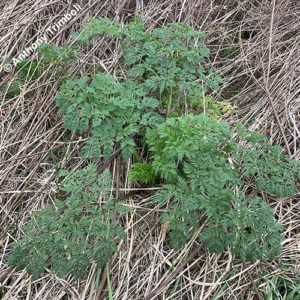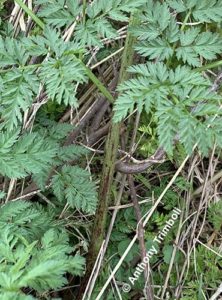By: Anthony Trimboli
Background
Poison hemlock (Conium maculatum) is an invasive weed that is found throughout the United States. It is commonly seen growing along roadsides, in ditches, and other disturbed areas with moist soils. Poison hemlock grows as a biennial in the colder portions of the U.S. That simply means that the first year it forms a basal rosette of leaves, then in its second year it puts up a flower stalk, sets seed, and dies. However, in areas of the United States that have a mild winter, it will grow as an annual and go through its entire life cycle in a single year.

Identifying Poison Hemlock
Identifying poison hemlock is straightforward. The foliage is deep green and the leaves are highly dissected. Think parsley or queen Ann’s lace on steroids. In much of the southeast, the leafy green basal rosettes will begin growing in the late winter. We frequently find it growing around our property in Kentucky by mid-January or early February. At that time of year, it is pretty much the only leafy, green forb growing against a background of dead or dormant brown vegetation. That makes it even easier to find.
Poison hemlock also has hollow stems that are marked with reddish to purplish blotches and streaks. However, be careful if you are going to break the stem to see if it is hollow. All parts of this plant are extremely toxic.
Warning
The poisonous compounds in poison hemlock can be fatal if ingested, absorbed through the skin from the sap, or accidentally inhaled as small particles after mowing. Some people are so sensitive that just touching the plant can result in a painful, itchy dermatitis. Do not handle this plant without gloves! Preferably ones that aren’t going to soak up the sap and transfer it to your skin that way.
Amazingly, despite the toxicity of poison hemlock, it was introduced to the United States in the 1880s as a garden plant. People wanted to grow it because of its attractive white flowers, impressive flowering height of six to ten feet, and late winter / early spring greenery.

Getting Rid of Poison Hemlock
Timing
Controlling poison hemlock is best accomplished in the winter and early spring when the plant is still in the rosette stage (all growth low to the ground). Once the plants start to form flowering stalks, they become more difficult to kill. Also, during the winter and early spring, most native plants are still dormant and will not be affected by possible overspray from chemical control measures.
Methods
Both chemical and mechanical control measures can be used to eradicate poison hemlock. Which method you choose will depend on a number of factors including the size of the infestation and your personal preference.
On small infestations consisting of only a few plants, mechanical methods of control can be effective. The best mechanical method is to simply pull up the plants. Remember to wear gloves that won’t soak up the sap! The entire taproot must be removed or the plant may resprout. You may have to go back multiple times to see if anything resprouted because you missed part of the root. If that happens, pull it again and try to get the rest of the root.
On larger infestations, chemical control is a much better option. Many herbicides are effective for controlling poison hemlock while it is in the rosette stage. Broadleaf selective herbicides such as 2,4,D and triclopyr as well as non-selective herbicides such as glyphosate have all been used to kill poison hemlock. Be sure to read and understand the label of any herbicide you are applying.
Regardless of which control method you implement, remember to check the site again next year. Poison hemlock seeds can remain viable in the soil for multiple years before sprouting, so even if you kill everything you find this year, you may still have new seedlings sprout next year.

Backyard Ecology: Exploring Nature in Your Backyard
Nature isn’t just “out there.” It’s all around us, including right outside our doors. Hi, my name is Shannon Trimboli, and I am the host of Backyard Ecology. I live in southcentral Kentucky and am a wildlife biologist, educator, author, beekeeper, and owner of a nursery specializing in plants for pollinators and wildlife conservation. I invite you to join me as we ignite our curiosity and natural wonder, explore our yards and communities, and improve our local pollinator and wildlife habitat. Learn more or subscribe to my email list at www.backyardecology.net.

Leave a Reply